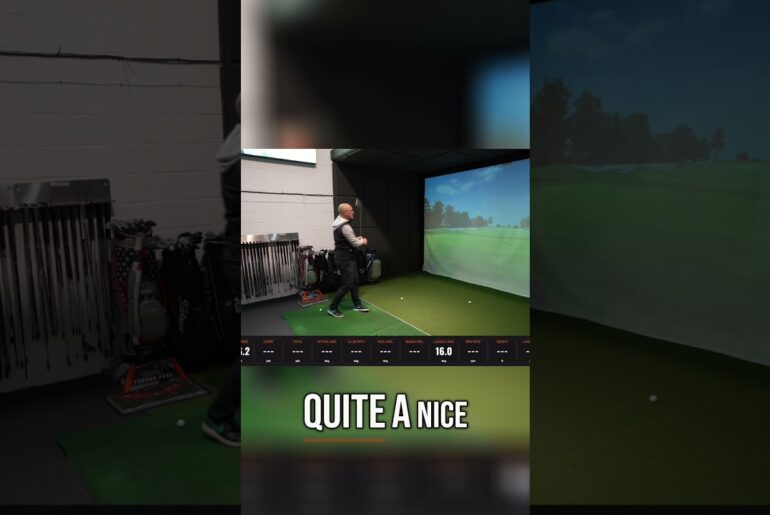In this video, equipment expert Joe Ferguson has been investigating why this particular club is still flying off the shelves of the biggest second hand golf club retailer 18 months after its original release!
► Skip to the section that interests you:
Introduction 0:00-0:44
Big Reveal 0:44
Key Tech 1:12
Shaft Length Test 4:19
Conclusion 10:08
► We teamed up with second hand golf club retailer golfclubs4cash to create this video, check out its website for the best prices on preowned equipment: https://www.golfclubs4cash.co.uk/
► Have you tried this club? How did you get on? Let us know in the comments below! 💬
► Watch more on Golf Monthly…
📹 2005 v 2015 v 2025 TaylorMade Driver Test! 👉 https://www.youtube.com/watch?v=H7IeNdMfXxQ
📹 We Select The 10 Best Clubs Of All Time (Probably) 👉 https://www.youtube.com/watch?v=nSlpbnSI0Y8
📹 Is Putter Tech A Myth? 👉 https://www.youtube.com/watch?v=ufCSYl8ndNg&t=4s
#golf #golfclubs #reviews #retro #taylormade #secondhand
🎵 Music – licensed by Epidemic Sound 🎵
► For the latest reviews, tips, new gear launches and tour news, visit our website: https://www.golfmonthly.com/
► Find us on social media:
Instagram – https://www.instagram.com/golfmonthly
TikTok – https://www.tiktok.com/@golfmonthly.com
Facebook – https://www.facebook.com/GolfMonthlyMagazine/
Twitter (X) – https://x.com/GolfMonthly
Under this head cover, I have the most purchased secondhand club of 2025. And in this video, I’m going to show you what that is, and we’re going to have a look at why it’s in so many people’s hands. So, I called up my friends at Golf Clubs for Cash, one of the leading retailers of pre-loved equipment. And I got them filtering through their database and their stats to find out which was the most sold club. And this one was way out in front. Well, as you can probably see, it’s a driver. And there’s your next clue. I’ve been hitting a pretty big draw with it. And your final clue here is I have been hitting this thing pretty much all over the club face and still getting some very flattering results. Have you got it yet? Well, it’s the Tailor Made Qi10 Max. So, I picked mine up for £287.99 from Golf Clubs for cash, which is around half what a lot of the newer models are retailing at. But what is it about this driver that’s putting it in so many people’s hands? Well, my first thought about this was, is it something to do with Rory and Scotty Sheffller? While they’re playing different models of this QI10, they’re playing more the core model. people are still seeing it on television with this familiar blue face and black crown. The contrast there, seeing it winning grand slams and multiple majors, and maybe they just want a piece of the action. My other thought is there is, as I showed there, a distinct draw bias to this model. So, so many of you out there will be struggling with that left to right slice. Again, maybe that’s part of the reason this is getting purchased by so many people. And also, we’ve got this 10K revolution. So, this is the driver that the whole Qi 10 range was named after because of the 10k inertia. It’s all about stability and moving weight back to make it as forgiving as possible. Permit me to demonstrate. Right, everybody, this is Tom. Say hi, Tom. Hi, Tom. Excellent. So, we’re going to demonstrate now. Tom’s going to stand there in his normal guys. And if I want to push him over, it’s really quite easy. Sorry about that, Tom. But what we’re going to do now is demonstrate the power of MOI and center of gravity. So Tom’s in the same sort of stance, but we’re going to move that foot back like we do with the Qi 10. Matt is getting all the weight back and all of a sudden he’s really quite difficult to move. So the level of stability and forgiveness on this driver is quite clearly a massive draw to all golfers. I said in my initial review on Golf Monthly, this might be one of the straightest drivers I’ve ever tried. But honestly, why it’s in so many people’s hands, I think the secret source may lie a little deeper. And I actually think it’s to do with playing length. So it’s all to do with the head design here. When they made this Qi10 Max driver and they wanted to spread the footprint out wide so they could get the mass and everything to the perimeter of the club, they kind of squashed the club down so they could spread it wider. And when they squashed that club down, the point where the shaft enters the head on this Qi 10 Max is actually lower to the ground. So, compared to the Qi10 Core or the Qi10 LS, this model, if you put the same shaft in, will play around quarter of an inch shorter than those other models. And I think it’s one of the reasons that so many people get on well with this driver without even realizing it. Many of you will know that drivers have just gotten longer and longer as a standard length over the past few years. There was a time not too long ago when the standard driver would have been about 44 or even 43 and 1/2 in. But with the quest for speed and the game getting bigger, manufacturers have been making their standard drivers longer and longer and longer. And what that does quite often is it makes it more difficult for people to find the center of the face. So I do wonder whether just making this slightly shorter in playing length without even people really noticing is helping people find the middle more and thus getting them more successful off the tea. It’s actually one of the many reasons why I think these mini drivers have been so successful over the past few years. getting back to a more controllable length for a lot of people. Like for example, this one for me that I play currently plays at 43 and 12 in. So again, like I said, back to kind of what a more standard driver used to be. So when I get over the ball, I feel like I can just find the center of the club face more easily. But I can hear many of you out there saying, if I go down in shaft length, isn’t that going to cost me club head speed and as such distance? Well, why don’t we find out? So, I brought with me three identical shafts. These are KBS PGW shafts, tailor-made tips on them, same grips, everything done the same, but I’ve got them at completely different length. So, I’ve got a 44 in, a 45 in, and a 46 in because I actually want to quantify this. I want to find out if I do lose speed when I go down in length or if I’m sacrificing everything else. So, let’s kick it off. Let’s hit a few shots. I’m going to start with the longest one. We’re going to start at 46 in. Right. All right. So, I’ve got the 46 in driver in my hands and already just waggling it. It feels a little bit more cumbersome. I play something around the 45 in mark as a general rule. So, even just that extra inch does feel a little bit cumbersome. So, I’ve got my Foresight Sports GC3 launch monitor here. Going to hit a few away and start to get an idea of club head speed and ball speed. That’s a good hit to start things going. Fairly impressive ball speed there. I’ll give myself that one. Let’s hit a few more away. Get some good averages and then we’ll have a chat about it. Let’s flip it over to the 45 and see what we get from there. Hey, Right. Okay. So, speedwise, some interesting stuff to talk about. I’m going to go and find a comfortable seat and I’ll walk you through it. Right. So, the data there is really interesting and I actually very much enjoyed doing that. I’ve been wanting to do that for some time. Just hit a load of different identical driver shafts of separate lengths to see what actually it does make in terms of difference to both club head speed and ball speed, which we’re going to talk about both here. So, in terms of club head speed, if you felt going down in shaft length was going to compromise your club head speed, well, yeah, you’re right. From my data here, that’s exactly what happened. And so I was at 115 mph with the 44in driver. I was at 117 mph with the 45 in driver. And I was nearly at 120 with the 46 in driver. So it’s kind of mid to late 119s there. So for sure the input as I would call it there. The club head speed has gone up. But when you look a little bit further, the output, which would be ball speed, so club head speed being our input, ball speed being our output, has actually gone completely the other way. So I’ll start with 46 in driver. I had nearly everything with that. My my best strike was nearly 180 mph of ball speed, which is great. But my worst strike was in the mid 160s, and that averaged out at 170.4 4 mph of ball speed with a smash factor, which for those of you who don’t know is your ball speed divided by your club head speed. So, it’s kind of a measure of efficiency of 1.42, which is a little bit on the low side for me there. So, that shows maybe I wasn’t quite hitting the center of the face as much as I would have liked to. When I went up to the 45in driver, sorry, rather down to the 45 in driver, my ball speed went up a little bit from that. So 171 mph, 1.46 smash factor. So that would suggest that I’m getting closer to the middle. When I went down into that 44 in drive, which I said felt like a junior club or even my 3-wood, well, that was my quickest ball speed despite having the slowest club head speed. So the slowest input gave me the quickest output. I was averaging 172.5 mph of ball speed there, which gave me a really super optimal smash factor of 1.5. And also dispersion, truth be told, I was all over the map with that 46 in driver. I didn’t find many fairways. I think probably one of the shots I hit would have been maybe center of the fairway. Other than that, there was a little bit there was a little bit of dispersion going on. However, the 44 in made it significantly easier, as I said, to find the center of the face. And the more I think about this and the more players I see, you very rarely see anyone flush the ball out the middle of the face miles offline. Most of the dispersion issues I see when I play proams or with people I’m doing fittings or lessons with or whatever, come from misruck shots. So, out of the heel and out of the toe. So, what we’ve got here, in my opinion, is going down in shaft length in this instance, at least for me, has allowed me to find the center of the face more, which has actually made it quicker, but not only is it quicker, being more in control of that club and finding the center of the face has actually made it straighter for me as well. So, there’s a lesson here, I think. If you struggle with your accuracy or off the tea at all, it really might well be worth experimenting with a shorter driver to see if you see the same results as me there. On top of that, sticking on top of it the QY10 Max, probably arguably the most stable driver I’ve tested in around five years, you’re probably in a good spot. So, that’s shown me exactly why so many people have been flocking to the secondhand market to buy this Tailor-Made Q i 10 Max driver. First off, it is incredibly stable and forgiving on those mis hits. Secondly, it does have that little bit of inherent draw bias to help mitigate that slice for a lot of people who struggle with that shot. And finally, I hope that little experiment I’ve done there in terms of shaft length has given you something to think about for your own game. Now, don’t forget to check out Golf Clubs for Cash. I’ll pop their website in the description below. Thanks for watching and we’ll see you next time.








7 Comments
Love this BUT if you didn't adjust swing weight the entire video useless!!! 2" is massive SW change. Come on guys.
Change camera angles doesn’t work. Makes it difficult to concentrate
Last thing I need is a draw based driver #foreleft 😂⛳
That’s a pretty magnificent headcover Joe! 😍 Legend has it that Robert Rock only gives those out to his best mates! 😂
Great video!! Side note, your swings looking class! Way shorter and more zippy! 👌👌👌
Exactly what I did, last winter I speed trained a lot then got to golf season and couldn’t hit water from a boat 🤢
Then went to 43’’ Ventus Blue on a Ping G430 10k max! Absolute winning combo! 🙏
Fantastic video Joe- now seriously considering a mini-driver… but also wondering if I can just put a 3w shaft into my driver ?
Isn't the question which club gets bought new then traded in/sold most often because it doesn't suit?
:p
Pushing poor Tom over is nothing to do with moment of inertia!